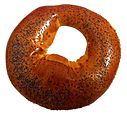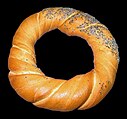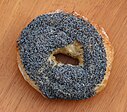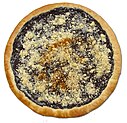List of poppy seed pastries and dishes
This is a list of poppy seed pastries and dishes. Poppy seed is an oilseed obtained from the opium poppy (Papaver somniferum). The tiny kidney-shaped seeds have been harvested from dried seed pods by various civilizations for thousands of years. The seeds are used, whole or ground, as an ingredient in many foods, and they are pressed to yield poppyseed oil. Poppy seeds are less than a millimeter in length,[1] and minute: it takes 3,300 poppy seeds to make up a gram, and a pound contains between 1 and 2 million seeds.[2] The primary flavor compound is 2-Pentylfuran.[3]
Poppy seed pastries and dishes
| Name | Image | Origin | Description |
|---|---|---|---|
| Bublik bread |  |
Ukraine | A traditional Ukrainian, Russian, Belarusian and Lithuanian (riestainis) bread roll. By far the most popular variety of bublik has a liberal amount of poppy seeds added to it. |
| Germknödel |  |
A fluffy yeast dough dumpling with a mix of poppy seeds and sugar, filled with spicy plum jam and melted butter on top, often eaten with vanilla cream sauce. It is a culinary speciality of Austria, Bavaria, and Bohemia. The dish is served both as a dessert and as a main course. | |
| Hamantashen |  |
A triangular cookie filled with fruit preserves or honey and black poppy seed paste, eaten during the Jewish holiday of Purim. Hamantashen are made with many different fillings, including poppy seed (the oldest and most traditional variety),[4] prunes, nut, date, apricot, apple, fruit preserves, cherry, chocolate, dulce de leche, halva, or even caramel or cheese.[5] Their formation varies from hard pastry to soft doughy casings. | |
| Kalach |  |
A traditional East Slavic bread, commonly served during various ritual meals.[6] The name originates from the Old Slavonic word kolo (коло) meaning "circle", "wheel". | |
| Kluski z makiem | Poland | Polish noodles with poppy seeds.[7] Polish Christmas dishes may include poppy seeds because they are thought to help with sleeping peacefully.[7] | |
| Kołacz |  |
Poland | A traditional pastry in Polish cuisine, originally a wedding cake that has made its way into American homes around the Christmas and Easter holidays. The pastry is a light and flaky dough filled with a variety of sweet and savory fillings such as apricot, raspberry, prune, sweet cheese, poppy seed or even a nut mixture. |
| Колач со афион (cake with poppy) | Republic of Macedonia | Poppy seed roll | |
| Kutia |  |
Ukraine | A sweet grain and poppy seed pudding from Ukraine.[8] |
| Lemon poppyseed muffins or cake |  |
These are popular in the US. | |
| Mákos bejgli |  |
Hungary | Hungarian poppyseed roll, also known as "Christmas bread"[9] |
| Mákos guba (Poppy seed bread pudding) | Hungary | A Hungarian bread pudding dessert made from crescent rolls, poppy seeds, and milk[10][11] | |
| Mákos metélt (Hungarian poppyseed pasta) | Hungary | A dessert in Hungarian cuisine made with noodles, poppy seeds and sugar.[12] | |
| Makovník | (photo link) | Slovakia | A nut roll filled with poppy seed paste |
| Makovnjača | Croatia | A Croatian poppy seed cake[13][14] or roll | |
| Makový závin | Czech Republic | Czech poppy seed roll | |
| Makówki |  |
A traditional poppy seed-based dessert from Central Europe. It is most notable in Silesia, where it is served almost exclusively on Christmas Eve (and perhaps on the following days, as long as the supply prepared for Christmas lasts). | |
| Mohnbeugel | A sweet filled pastry with poppy seeds | ||
| Mohnstriezel |  |
Germany | German poppyseed cake[15][16] |
| Mohnstrudel |  |
Poppyseed strudel popular in Germany and Austria[17][18][19] | |
| Obwarzanek krakowski |  |
Kraków, Poland | A ring-shaped bread product made of strands of dough twisted into a spiral that is boiled and sprinkled with salt, poppy seeds, sesame seeds, etc., before being baked |
| Poppy seed bagel |  |
Bagels with poppy seeds, often on top. Poppy seeds are sometimes called by their Yiddish name, spelled either mun or mon (written מאָן) which is very similar to the German word for poppy, Mohn, as used in Mohnbrötchen. | |
| Poppy seed kolache (or kolachy)[20][21] |  |
A type of pastry that holds a dollop of fruit rimmed by a puffy pillow of supple dough.[22] Originating as a semisweet wedding dessert from Central Europe, they have become popular in parts of the United States. The word kolache (колаче) itself means 'a small cookie' in Macedonian. | |
| Poppy seed roll |  |
A pastry consisting of a roll of sweet yeast bread (a viennoiserie) with a dense, rich, bittersweet filling of poppy seed. An alternative filling is a paste of minced walnuts, making it a walnut roll. The dough is made of flour, sugar, egg yolk, milk or sour cream and butter, and yeast.[23] The dough may be flavored with lemon or orange zest or rum. The poppy seed filling[24] may contain ground poppy seeds, raisins, butter or milk, sugar or honey, rum and vanilla. It is popular in parts of Central Europe, Eastern Europe and in Israel. It is commonly eaten at Christmas and Easter time.
It is traditional in several cuisines, including the Hungarian cuisine (mákos bejgli[25]), Russian cuisine (bulochki s makom Template:Lang-ru), Serbian cuisine (маковњача), Bosnian cuisine (makovnjača), Polish cuisine (makowiec), Czech cuisine (makový závin), Slovak cuisine (makovník), Lithuanian cuisine (aguonų vyniotinis), Croatian cuisine (makovnjača), Romanian cuisine (ruladă cu mac or ruladă cu nuci), and Austrian cuisine (Mohnkuchen or Mohnstriezel Danish cuisine: [ˈʋiːˀnɔˌbʁœːˀð] | |
| Prekmurska gibanica |  |
A cake made with poppy seeds, cottage cheese, walnuts, and apples from Slovenia[26] | |
| Rice puddings (various) (esp. with black poppy seeds) |  |
Such as "Mohnpielen," a Silesian chilled bread and poppy seed pudding,[27] and a Senegalese-influenced lime-scented poppy-seed rice pudding by Marcus Samuelsson[28] | |
| Štrudla s makom | Serbia/Montenegro | A Serbian/Montenegran poppy seed strudel, cake[29] or roll | |
| Sushki |  |
Russia | Traditional Russian and Ukrainian tea breads. Similarly to the bubliki, they are often topped with poppy seeds. Usually, poppy seeds are also added to the dough. |
See also
References
- ^ Yearbook of Agriculture. United States Government Printing Office. 1896. p. 203.
- ^ Harold McGee (2004). On Food and Cooking: The Science and Lore of the Kitchen. Simon and Schuster. p. 513. ISBN 978-0-684-80001-1.
- ^ Yiu H. Hui, Handbook of Food Science, Technology, and Engineering. CRC Press 2006. ISBN 0-8493-9848-7
- ^ What is Hamantashen?
- ^ Epi Log: The latest in Food News, the Culinary Arts & Cooking
- ^ Julian, Sheryl (2000-12-20). "Seasoned celebrations on Christmas Eve, making the traditional Old World feast is a family affair". Boston Globe. Retrieved 2009-03-17.
- ^ a b Kari A. Cornell; Robert L. Wolfe (2001). Holiday Cooking Around the World: Revised and Expanded to Included New Low-fat and Vegetarian Recipes. Twenty-First Century Books. p. 43. ISBN 9780822541288.
- ^ Ginsburg, Ezra (2009-01-07). "Joyous, family celebration marks Ukrainian Christmas". Sun Media (Winnipeg). Retrieved 2009-01-24.
- ^ "Mâkos és Diós Kalács," in Bernard Clayton; Donnie Cameron (2003). Bernard Clayton's New Complete Book of Breads (30th ed.). Simon and Schuster. pp. 308–10. ISBN 9780743234726.
- ^ Mayer, Christina (2005). Hungarian Phrasebook. Lonely Planet. p. 178. ISBN 9781741042320.
- ^ "Hungary: "There is no need to amend our EU communication strategy"". Euractiv.com. 2006-02-06. Retrieved 2009-01-24.
- ^ Encyclopedia of Jewish Food - Gil Marks - Google Books
- ^ The Rough Guide to Croatia - Jonathan Bousfield - Google Books
- ^ Croatia 5 - Vesna Maric - Google Books
- ^ "Breslauer Mohnstriezel". SWR. 2005-07-15. Retrieved 2009-03-17.[dead link]
- ^ "Recipe Exchange". Hartford Courant. 2004-09-23. p. G4. Retrieved 2009-03-17.
- ^ Maschewski, A. (2005-11-27). "Kunstvoll und facettenreich". Berliner Morgenpost. Retrieved 2009-03-17.
- ^ "Filling Vienna's Sweet Tooth". New York Times. 1977-06-08. Retrieved 2009-03-17.
- ^ Seeger, Sabine (2007-12-19). "Der Tannenbaum des Anstoßes". Südwest Presse. Retrieved 2009-03-17.
- ^ Frederic Gomes Cassidy; Joan Houston Hall (1985). Dictionary of American Regional English. Harvard UP. p. 256. ISBN 9780674205192.
- ^ "Poppy Seed Kolache". Simply Recipes. 2007-09-30. Retrieved 2009-01-16.
- ^ "Czech, Please: 2000s Archive : gourmet.com". Prod.gourmet.com. 2011-08-01. Retrieved 2012-02-20.
- ^ Dorcas Guild of the Magyar United Church of Christ, ed. (1960). Hungarian recipes. Elyria, Ohio. p. 44.
{{cite book}}: CS1 maint: location missing publisher (link) - ^ Mákos bejgli
- ^ June Meyers Authentic Hungarian Heirloom Recipes Cookbook
- ^ Janez Bogataj; Lučka Letič. "Taste Slovenia" (PDF). Slovenian Tourist Board. Retrieved 2009-01-19. P. 12.
- ^ Ursula Heinzelmann. "Chilled Bread and Poppy Seed Pudding". Saveur. Retrieved 2009-01-17.
- ^ Marcus Samuelsson. "Lime-Scented Poppy-Seed Rice Pudding with Mango". Food & Wine. Retrieved 2009-01-17.
- ^ The Rough Guide to Montenegro - Darren (Norm) Longley, Rough Guides - Google Books
